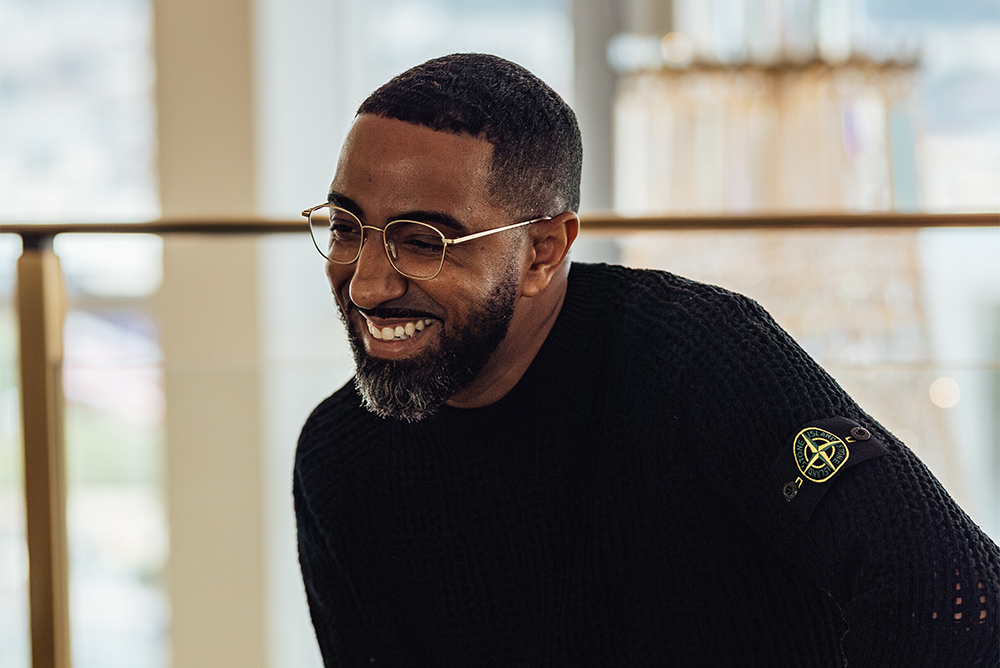
Photo by Chad Brady.
Khalil Kinsey is the COO and chief curator of The Kinsey African American Art & History Collection and Foundation. Before joining the Zócalo/The Music Center program “How Is Art A Weapon in War?,” Kinsey chatted with us in the green room about antiwar art, the family business, and his direct connection to one of the most significant pieces in the Kinsey Collection.
Who is your dream dinner guest (dead or alive)?
I’d love to have dinner with my grandfather one more time. He was an incredible guy. We had such great conversations. He was an educator, and we became really close later in his life. I was actually a caretaker of his as he got ill. The conversations that we had I would love to have more of.
What would you serve him?
Fried pork chops. My grandmother had the special recipe for them, but she was one of those that didn’t share them. But I snuck around and was able to reassemble. So I would do that because he loved that dish.
What’s one of your favorite songs, movies, books, shows, or artworks about war?
There’s a lot. Marvin Gaye’s “What’s Going On?” is a great one. It’s that balance of something that is very heavy but also very beautiful as far as the presentation of it. So it allows for the medicine in the candy.
When I think about war, I think about a lot of different types of war. The work that I do is really around consciousness and resistance. One thing I always loved is the Black Panther propaganda pieces by Emory Douglas. The Black Panther newspapers in which there were incredible drawings, pieces of art as covers, but they were talking about things that were really about this war going on against the Black community, and about the police.
The Kinsey Collection is a family affair. How did it begin?
It began with my mother and father, a little influenced by myself as a baby. My parents were growing in their consciousness and were really striving to know more and be able to share more with me. And that evolved into a deep, deep dive in terms of their and my history and background and an understanding of a fuller presence here in American society. One of higher significance, of contribution, brilliance, and strength. That was kind of what really informed their steps moving forward. They had this boy that they knew wasn’t going to get that full education in school. They wanted to provide that in our home.
What’s one of your personal favorite artifacts in the collection?
It varies often, because for me there are things that I can sit with or relate to just based off of different experiences in my own life. But there are a lot of personal pieces that have direct connections to my family. One is a letter my father discovered while reading Slavery by Another Name by Douglas A. Blackmon. On page eight of that book is a letter to President Roosevelt, written in 1903, from Bainbridge, Georgia. It’s from a young girl seeking out her brother who had been kidnapped by the sheriff of the county. It is signed Carrie Kinsey. My father was like this has got to be a relative. And so after some time my father and Doug Blackmon were able to go to the National Archives to retrieve the letter. It’s now in our collection.
That letter is one of thousands of letters that were never opened that were sent to different powers that be by Black people seeking out their family. It was part of the chain gang system—this new formula for free labor that America came up with that was in some ways more heinous than slavery because there was no value ascribed to life—you could just be picked up and leased out to American railroad companies, U.S. Steel, all these organization s associated with the Industrial Revolution. Turns out that Carrie Kinsey was my third cousin; my grandfather’s first cousin. So having that direct connection to a relative, but also how significant that period of time is in terms of the DNA of the prison industrial complex, mass incarceration, “stop-and-frisk,” the over-policing of Black and brown communities. They really come out of that time, when the narrative was that Black people were inherently criminal—guilty until proven innocent.
Let’s play either/or. If you had to pick one right now, which would it be?
a. The Ocean or mountains — Ocean.
b. Palisades or Santa Monica — Palisades.
c. Talib Kweli or Mos Def — Mos.
d. Skateboarding or snowboarding — Skateboarding, but they’re equal to me.
e. The Dime or The Short Stop — The Dime, easy.
f. Langer’s Deli or Canter’s Deli — Canter’s; I’m a Fairfax kid.



